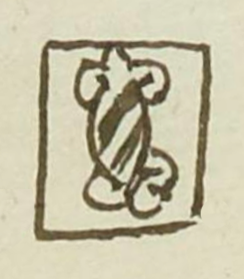Tetlacuilol (MH605r)
This black-line drawing of the compound glyph for the personal name or occupation Tetlacuilol (“Stone Carving,” attested here as a man’s name) shows a vertical stone (tetl) with curling ends and alternating dark and light diagonal stripes across its middle. Surrounding this stone is a rectangle that seems meant to call to mind a piece of paper upon which one could add writing (tlacuilolli).
Stephanie Wood
A number of compound glyphs for the names Tetlacuilol and Tetlacuilolli glyphs appear below, showing some variety in execution, but the reading seems to remain the same. See also the blank rectangle for tlacuilolli, below.
Marc Thouvenot identifies the verb icuiloa (or ihcuiloa, with the glottal stop), which means to paint, write, or print, as having a root of -cuil-. He notes how it also appears in tlacuiloliztli (writing), tlacuilo (writer), and cuicuiltic (mottled). He goes on to show various uses of icuiloa that take it beyond the simple definitions just given, resulting in something like the action of creating a design (e.g., on leather, ceramics, sculpture, or in textiles). It can also be something like the action of decorating (e.g., to put a flower on a cup of atole). He associates icuiloa and tlacuilolli with "cultural artifacts," such as arts and crafts or examples of writing and painting, but cuicuiltic with effects created by "nature." This short summary barely does his article justice; it is worth reading the entire piece. How Thouvenot's study might connect with the concept of bent or curved mentioned by Prem (1974: 555, 682) raises an interesting question. Perhaps the bent or curved lines of writing, painting, carving, embroidery, and so on, fall with in the realm of expressions of -cuil-. See
Marc Thouvenot, "Imágenes y escritura entre los nahuas del inicio del XVI," Estudios de Cultural Náhuatl 41 (2010).
Stephanie Wood
1560
Jeff Haskett-Wood
piedras, diseños, escrituras

te(tl), stone, https://nahuatl.wired-humanities.org/content/tetl-0
tlacuilol(li), piece of writing, a painting, or a design, https://nahuatl.wired-humanities.org/content/tlacuilolli
un dibujo en piedra
Stephanie Wood
Matrícula de Huexotzinco, folio 605r, World Digital Library, https://www.loc.gov/resource/gdcwdl.wdl_15282/?sp=292&st=image.
This manuscript is hosted by the Library of Congress and the World Digital Library; used here with the Creative Commons, “Attribution-NonCommercial-ShareAlike 3.0 License” (CC-BY-NC-SAq 3.0).









